| |
|
|
From Petsamo to Inari
The Petsamo area, which became part of Finland in connection with the
Peace of Tartu, was the homeland of the Suonjel, Paatsjoki and Petsamo
Sámi. They were the indigenous population of the area. In the course
of several centuries, other people, too, moved into the area: Russians,
Karelians, Sea and Fell Sámi from Norway, Finns, and even some
Komi. These immigrant groups naturally narrowed down the living conditions
of the indigenous inhabitants and were a hinder to their lifestyle which
was based on a yearly migration pattern.
This migration cycle was determined by the fishing opportunities, and
reindeer herding was adjusted to fishing. Only the Sámi of the
Suonjel, or Suonikylä, village could follow the migration pattern
and move between their traditional family areas - between the winter,
spring, summer and autumn places. However, the village lost part of its
native lands as a result of World War I. The border defined by the Tartu
Peace Treaty was drawn as straight as an arrow through the family lands
of the Sverloffs, from the fell Korvatunturi to Vaitolahti Bay on the
Barents Sea. The border of the Tartu Peace Treaty cut off many traditional
livelihood connections, but it also severed the contacts to the relatives
in the neighboring villages.
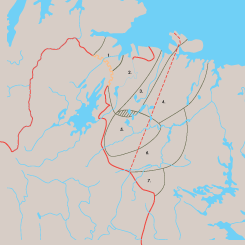 |
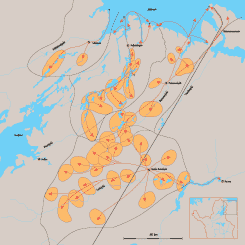 |
| Skolt Sámi siidas:
1) Näätämö, 2) Paatsjoki, 3) Petsamo, 4) Muotka,
5) Suonikylä, 6) Nuortijärvi, 7) Hirvas. Map: Sámi
Museum Siida |
Yearly migration routes
of the Skolt Sámi siidas in the Petsamo Region as recorded
at the beginning of the 20th century. Map: Sámi Museum Siida |
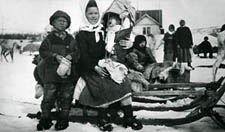 |
| Fedosia Jefremoff with her children
by the Petsamo Fjord - preparing to move to thefamily´s summer
camp in the wilderness. Photo: National Board of Antiquities |
The Petsamo area was divided between the above-mentioned three Sámi
communities so that each village had its territory along a distinct river
system: on the river system of Paatsjoki, Petsamojoki or Tuulomajoki-Luttojoki.
The borders between the villages were very exact. Sometimes, a village
meeting would decide that part of its land could be used by a neighboring
village for a certain period. The village administration was the indigenous
population's own way of regulating livelihood and social relationships
within its territory. The heads of the families gathered to discuss and
to decide over important up-to-date matters. Each community chose its
own representative, the Village Elder, to preside over the administration
of the community.
After Petsamo became part of Finland, it was even more difficult to carry
on the traditional trades. New groups of people came to Petsamo, as the
road made these remote areas easily accessible. Especially in the field
of sea fishing, traditional fishing grounds were surrendered to the newcomers.
The Skolt Sámi swore an oath of allegiance to the State of Finland,
but the new home country paid little attention to the rights of the indigenous
population of the area.
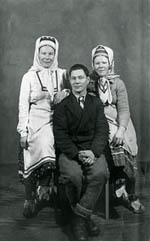 |
| Darja, Elli and Saveli
had themselves photographed at a studio in Kalajoki during their evacuation
trip. Photo: Private Archive |
The outbreak of the Winter War in 1939 forced the Sámi of the
Petsamo area on an evacuation trip: the Sámi living in Suonikylä
went to Tervola, and those living in Paatsjoki to the neighboring country
Norway. As regards the Sámi living in the village of Petsamo, the
Finnish evacuation authorities were, however, too late, and the inhabitants
of this community were evacuated to the Soviet Union, to central Kola
Peninsula. In 1944, during the next phase of the war in Finland - the
Continuation War - all the Sámi of the Petsamo area were evacuated
to Ostrobothnia: to the regions of Kalajoki and Oulu. They got permission
to return to the north in the summer of 1945, and some as late as in 1946.
The area of Petsamo had been lost in the war, so the Sámi of the
area needed new home regions. They settled temporarily in the area between
Nellim, Raja-Jooseppi and Ivalo, waiting for the decision on their final
homelands. In the end, the Sámi of the Petsamo village settled
permanently in the Nellim area, the Sámi of the Paatsjoki village
in Keväjärvi and the Sámi of the Suonjel, or Suonikylä,
village in the Sevettijärvi-Näätämö area. A few
families from the Paatsjoki community settled in Sevettijärvi, closer
to the Norwegian border, and a few Sámi from the Suonikylä
village in the region of Nellim.
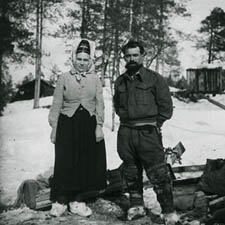 |
| Before finding a permanent place
to live in, the Skolts stayed in temporary lodges on the River Lutto
and Lake Tsarmijärvi, and in Pikku-Petsamo in the vicinity of
Ivalo. Uljana and Matti Fofanoff on Lake Nangujärvi. Photo: Private
Archive |
For the most part, the Skolt Sámi settled permanently in their
new homelands in the course of 1949. Later, a law on Skolt Sámi
settlement was passed, defining for instance the rights of the Skolt Sámi
to land and waters in their new home regions.
|
|
